#17th c. italy
Text

Portrait of a woman; North Italian School, second half of the 17th Century, c. 1670s
265 notes
·
View notes
Note
I've seen a post you've reblogged and added to, among many things about women showing nipples. Can you recommend any ref material (articles, videos, etc.) are share your knowledge about this? Cause I'm curious about that, as nowadays going out in a shirt without a bra makes you indecent, while in like 90s it was okayish? I wonder how it was in previous centuries.
There is a really cool academic paper about bare breast dresses in 17th century England specifically. I think anyone can read it by creating a free account.
Abby Cox also has a good video about the cleavage during the past 500 years in which she goes through also the nip slip phenomena.
I don't have other sources that specifically focus on this subject, though many sources about specific decades touch on it, but I do have my primary source image collection, so I can sum up the history of the bare nipple.
So my findings from primary source images (I could be wrong and maybe I just haven't found earlier examples) is that the Venetians were the first ones to show the nipple for courtly fashion. At the same time in other places in Europe they sported the early Elizabethan no-boob style that completely covered and flattened the chest. In the other corners of Italy the necklines were also low but less extreme. Venetian kirtle necklines dropped extremely low as early as 1560s and they combined extremely sheer, basically see-through partlets with their kirtle. First example below is a 1565-70 portrait of a Venetian lady with the nipples just barely covered waiting slip into view with a movement of arm. There was an even more extreme version of this with the kirtle being literally underboob style, still with a sheer doublet. Though I believe this was not quite for the respectable ladies, since I have only seen it depicted on high class courtesans. They were not exactly respectable ladies, but they did have quite good social position. The second example is a 1570s depiction of a courtesan, which is revealed by the horned hairstyle. By the end of the century this underbust style with only see through fabric covering breasts, had become respectable. In the last example it's shown on the wife of the Venetian doge in 1597.
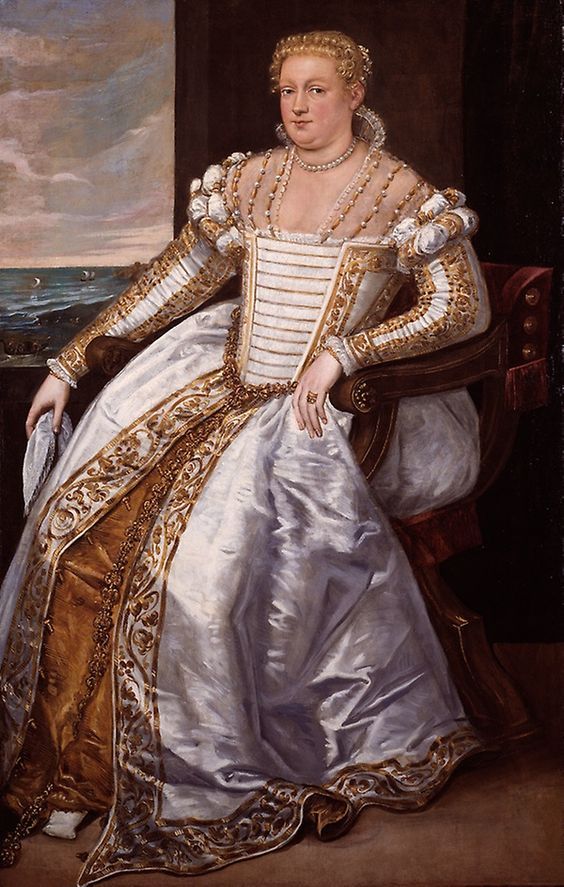
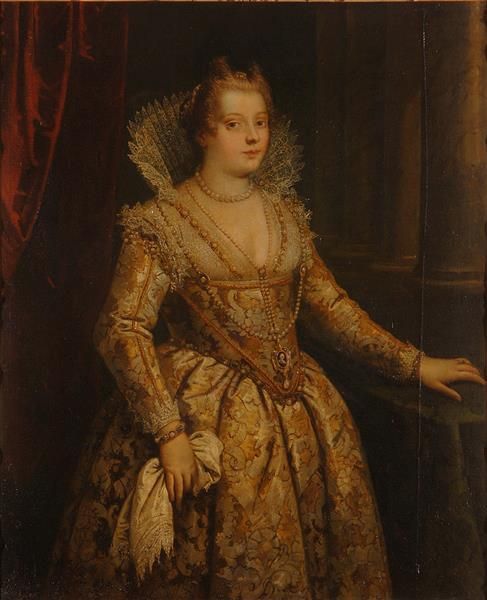

Around the same time, at the very end of 1500s, the extremely low cut bodice fashion enters rest of Europe. The low cut style was present in the bodices of all classes, but the nipple was really only an aristocrat thing. The lower classes would cover their breasts with a partlet, that was not sheer. Bare breast was ironically from our perspective a show of innocence, youthful beauty and virtue, and to pull off the style with respect, you also had to embody those ideals. Lower class women were considered inherently vulgar and lacking virtue, so a nipple in their case was seen as indecent. Bare boobs were also a sort of status symbol, since the upper class would hire wet nurses to breastfeed their children so they could show of their youthful boobs.
Covering partlets and bodices were still also used in the first decade of 1600s by nobles and the nip slip was mostly reserved for the courtly events. The first image below is an early example of English extremely low neckline that certainly couldn't contain boobs even with a bit of movement from 1597. The 1610s started around 5 decades of fashion that showed the whole boob. The first three were the most extreme. Here's some highlights: The second image is from 1619.
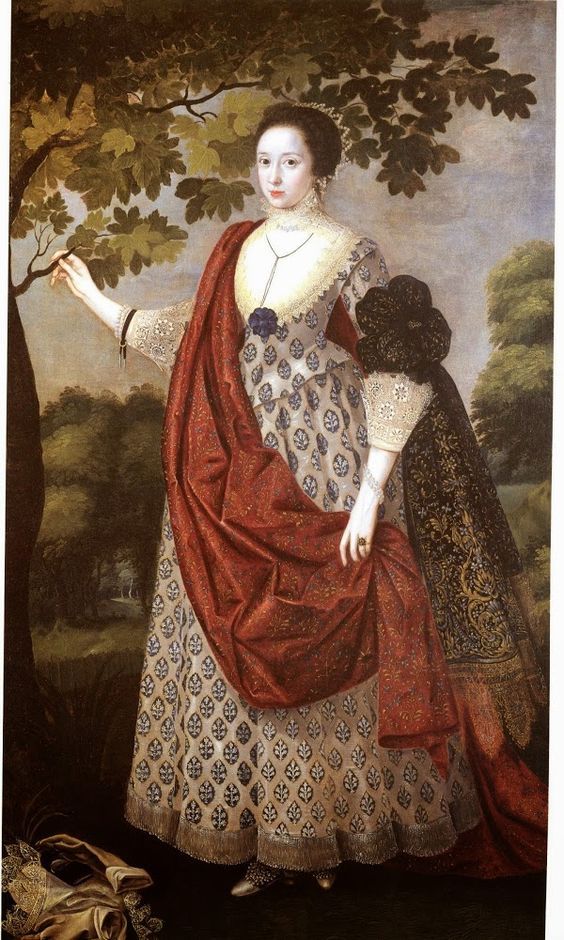

Here the first, very much showing nipples, from c. 1630. The second from 1632.
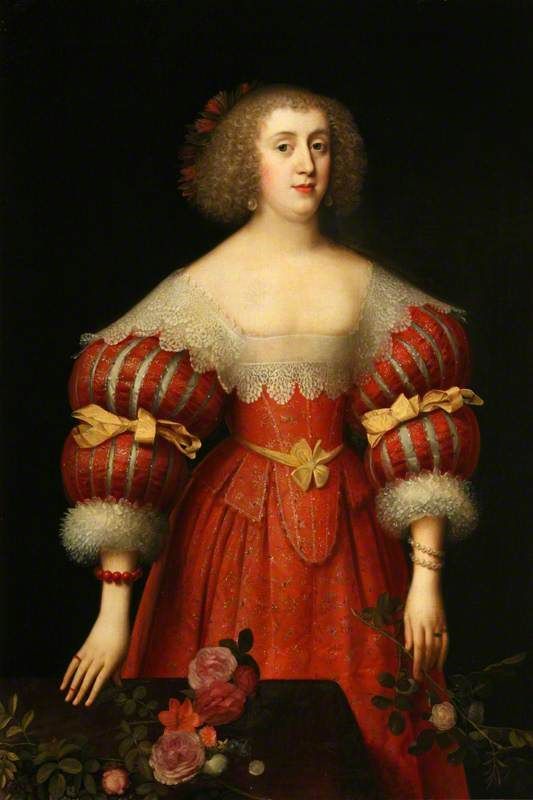
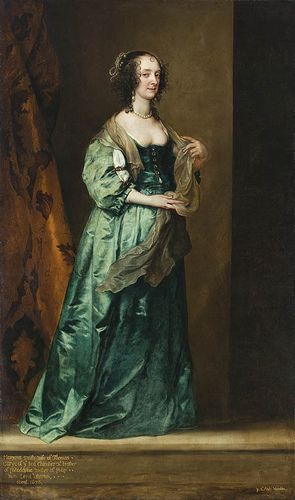
The neckline would slowly and slightly rise during the next decades, but nip slips were still expected. Here's an example from 1649 and then from 1650-55. In 1660s the neckline would get still slightly higher and by 1870s it was in a not very slippable hight. The necklines would stay low for the next century, though mostly not in boob showing territory, but we'll get there. But I will say that covering the neckline in casual context was expected. Boobs were mostly for fancy occasions. It was considered vain to show off your boobs when the occasion didn't call for it and covering up during the day was necessary for a respectable lady. You wouldn't want to have tan in your milk-white skin like a poor, and also they didn't have sun screen so burning was a reasonable concern.

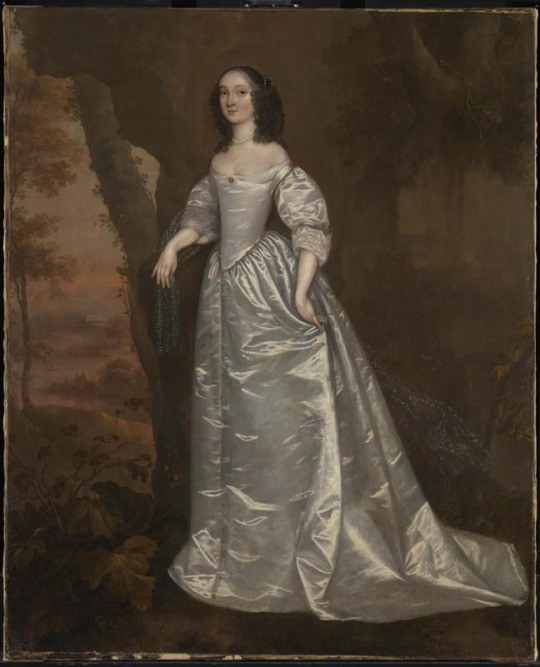
1720s to 1740s saw necklines that went to the nip slip territory, though they didn't go quite as low as 100 years earlier. The nipple was present in the French courtly fashion especially and rouging your nipples to enhance them was popular. Émilie Du Châtelet (1706-1749), who was an accomplished physicist and made contributions to Newtonian mechanics, was known in the French court to show off her boobies. An icon. Here she is in 1748. Here's another example from this era from 1728.
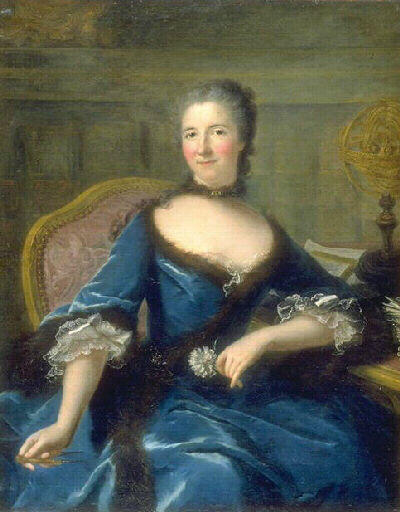
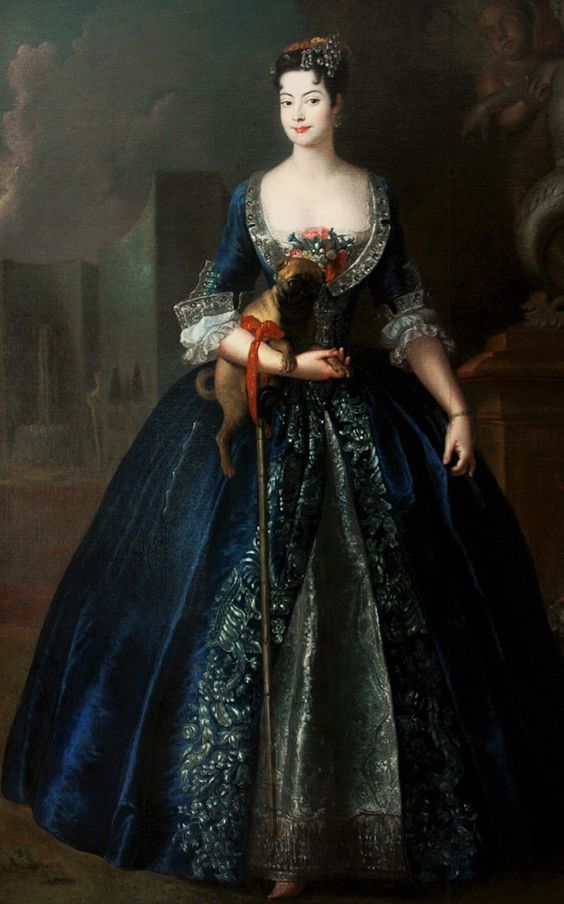
The Rococo neckline never got high, but in the middle of the century it was less low till 1770s when it plunged into new lows. In 1770s the fashion reached a saturation point, when everything was the most. This included boobs. The most boob visible. There was a change in the attitudes though. The visible boob was not a scandal, but it was risque, instead of sing of innocent and did cause offense in certain circles. I think it's because of the French revolution values gaining momentum. I talked about this in length in another post, mostly in context of masculinity, but till that point femininity and masculinity had been mostly reserved for the aristocracy. Gender performance was mostly performance of wealth. The revolutionaries constructed new masculinity and femininity, which laid the groundwork for the modern gender, in opposition to the aristocracy and their decadence. The new femininity was decent, moral and motherly, an early version of the Victorian angel of the house. The boob was present in the revolutionary imagery, but in an abstract presentation. I can't say for sure, but I think bare breasts became indecent because it was specifically fashion of the indecent French aristocracy.
Here's example somewhere from the decade and another from 1778. The neckline stayed quite low for the 1780s, but rose to cover the boobs for the 1790s.

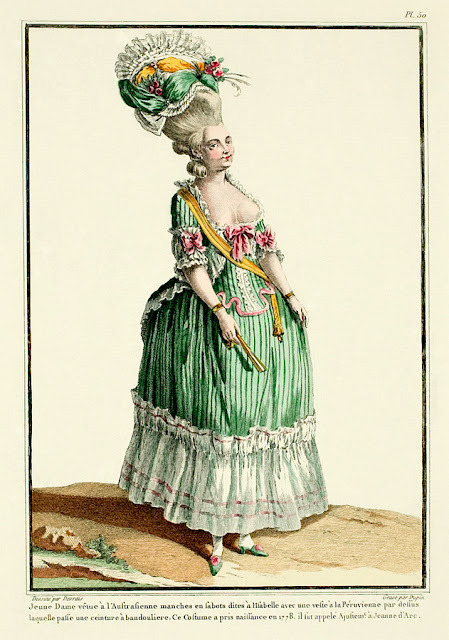
The nipple didn't stay hidden for long but made a quick comeback in the Regency evening fashion. It was somewhat scandalous by this point, and the nipple and sheer fabrics of the Regency fashion gained much scorn and satire. The styles that were in the high danger nip slip territory and those that allowed the nipple to show through fabric, were still quite popular. The sleeves had been mid length for two centuries, but in 1790s they had made a split between evening and day wear. The evening sleeves were tiny, just covering the shoulder. Showing that would have been a little too much. Like a bare boob? A risque choice but fine. A shoulder? Straight to the horny jail. (I'm joking they did have sheer sleeves and sometimes portraits with exposed shoulder.) But long sleeves became the standard part of the day wear. Getting sun was still not acceptable for the same reasonable and unreasonable reasons. Day dresses did also usually have higher necklines or were at least worn with a chemisette to cover the neckline. Fine Indian muslin was a huge trend. It was extremely sheer and used in multiple layers to build up some cover. There were claims that a gust of wind would render the ladies practically naked, though because they were wearing their underclothing including a shift, which certainly wasn't made from the very expensive muslin, I'm guessing this was an exaggeration. Especially though in the first decade, short underboob stays were fairly popular, so combined with a muslin, nipples were seen. Here's an early 1798 example of exactly that. The short stays did disappear eventually, but in 1810s the extremely small bodices did provide nip slip opportunities, as seen in this 1811 fashion plate.
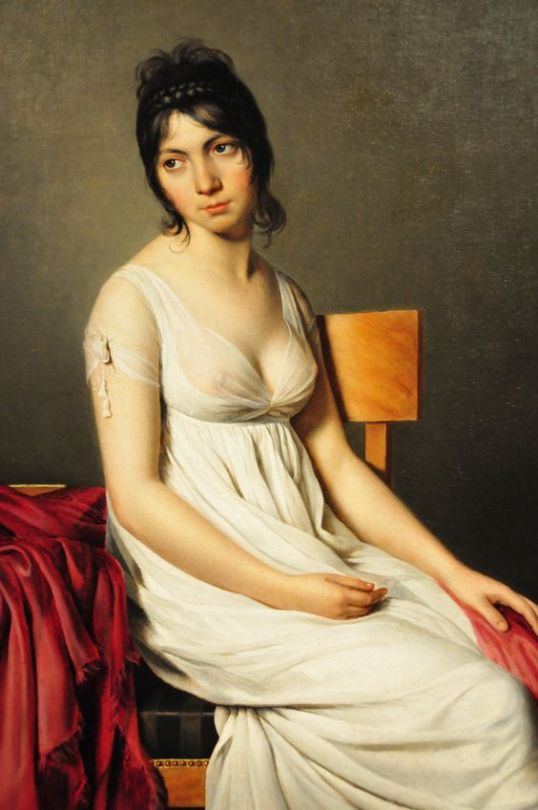
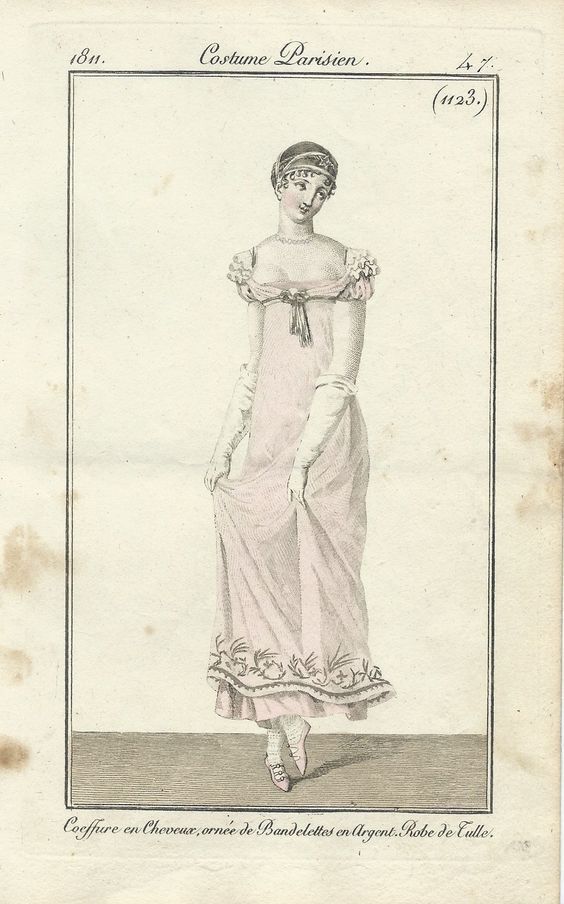
Victorian moralizing did fully kill the nip slip, though at least they were gender neutral about it. The male nipple was just as offensive to them. In 1890s, when bodybuilding became a big thing, bodybuilder men were arrested for public indecency for not wearing a shirt.
#there was also the new femininity aspect to regency nipple which had to do with breastfeeding becoming fashionable among upper class#it's about the whole motherly thing that came with the french revolution#i can't remember the book i read it from so i didn't go into it because i couldn't remember the details lol#but it did definitely have an effect to the fashion and to the perception of nipple#historical fashion#fashion history#history#dress history#fashion#answers#painting#fashion plate#renaissance fashion#elizabethan fashion#rococo fashion#baroque fashion#regency fashion#will tumblr prove itself to be again more prudish than elizabethans and label my post as mature content?#remains to be seen
504 notes
·
View notes
Text

Il Gatto Domestico (The House Cat)
c. 1800
Printed and published by Remondini, Bassano del Grappa, Italy (active mid- 17th century to 1860)
Philadelphia Museum of Art
531 notes
·
View notes
Text
Upcoming Exhibit and Lecture: Illustrating the Renaissance Book: From Illumination to Woodcut
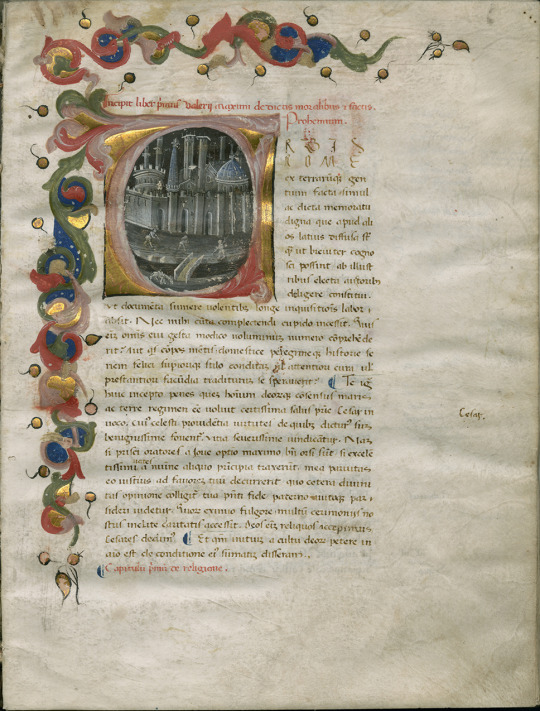
Valerius Maximus (1st c. AD). Factorum ac dictorum memorabilium libri IX. Italy. 15th c. Parchment,126 fols. Fol. 5r

Full-page illumination from Carta Executoria de hidalguia de sangre a pedimento de Don Juan de Mansilla como curador de Doña Francisca de Mansilla, hija de Baltasar de Mansilla, vecinos de la villa de Aranda de Duero. Valladolid, 1636 Parchment, 93 fols. Fol. 2r

Full-page woodcut depicting the procession of Priapus, the Greek god of animal and vegetable fertility. Hypnerotomachie, ou Discours du songe de Poliphile Ed: Jean Martin Paris: Jean le Blanc for Jacques Kerver, 1561 Fol. 69r. Loan courtesy of William P. Heidrich
Come explore a selection of manuscripts and early printed books from the 15th to the 17th centuries that were illustrated with illuminations and woodcuts! The display will be up in the Hatcher Gallery Exhibit Room from 6 September to 14 December.
And join us on Wednesday 13 September at 4p in the Hatcher Gallery event space or on zoom a for lecture based on the exhibit.
We hope to see you there!
#events#exhibits#special collections#special collections libraries#libraries#archives#libraries and archives#special collections and archives#manuscripts#manuscript culture#early printed books#book illustrations#illustrated books#illustrations#illumination#illuminated manuscripts#manuscript illumination#woodcuts
87 notes
·
View notes
Photo

Here’s the story of the little wine doors of Florence, Italy. Of the millions of tourists that visit Florence, how many of them walk by the old palazzos without ever noticing their most interesting little secret hiding in plain sight?

About 18 cent.(7″) wide and 35 cent.(1′1″) high, they are just the right height to fit a bottle of wine.

The buchette del vino, the wine windows of Florence, are totally unique to Florentine architecture, dating back to the 17th century when they were used for the sale of wine directly on the street.

With a knock and a few coins, any Florentine citizen could conveniently purchase a glass of wine or a bottle from a local vineyard.

It was a time when upheavals in the European markets led to a decline in manufacturing and international trade for the noble Florentine families. The buchette del vino (literally, “the wine holes”), allowed the savvy aristocrat to cut out the middle man and sell their wine straight from their residence.

Also, b/c of the Black Plague, the use of wine windows provided the safe sale of wine, without direct contact between client and seller.

Some charitable families gave food and wine to the poor. The height of the doors also provided anonymity.

Today, there are only 140 buchette left. They don’t pass out wine and some are converted to mail slots, door bells, intercoms, but the majority of them were plastered over.

But, wait! During the Covid pandemic, as Italy emerged from lockdown, some enterprising Wine Window owners have turned back the clock and are using their Wine Windows to dispense glasses of wine, cups of coffee, drinks, sandwiches and ice cream—all germ-free, contactless! Bravo!
https://www.messynessychic.com/
576 notes
·
View notes
Text
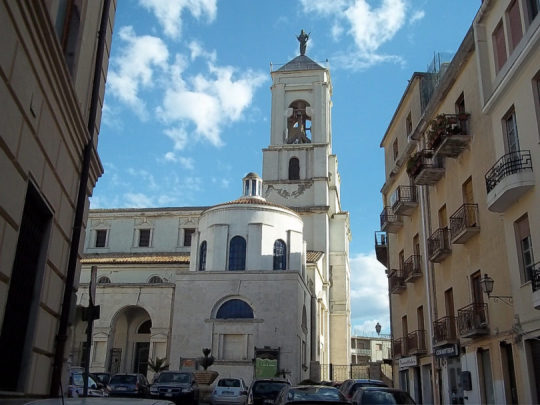

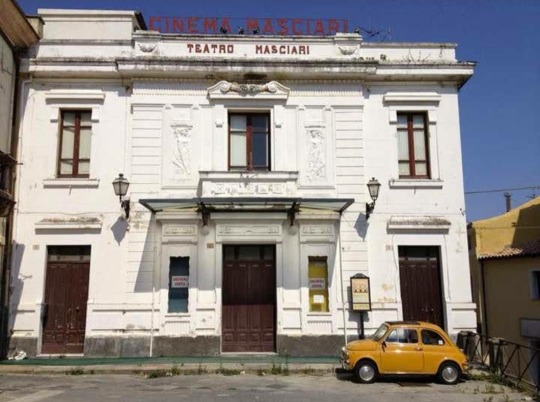
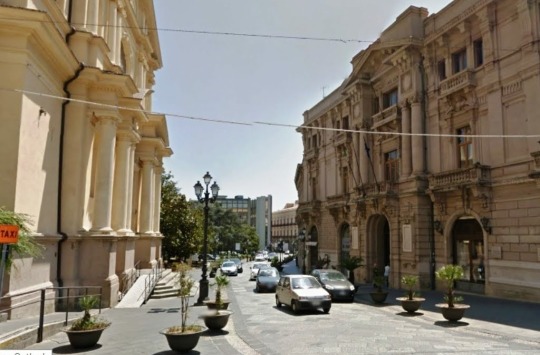


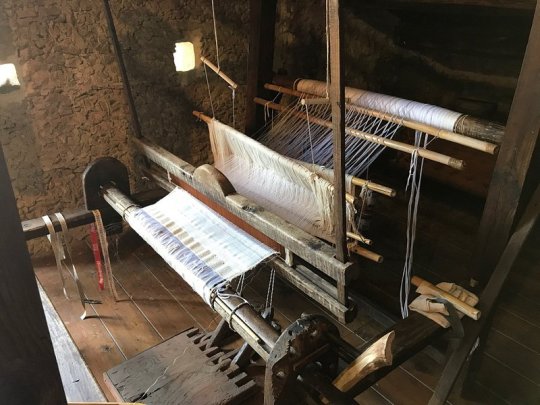
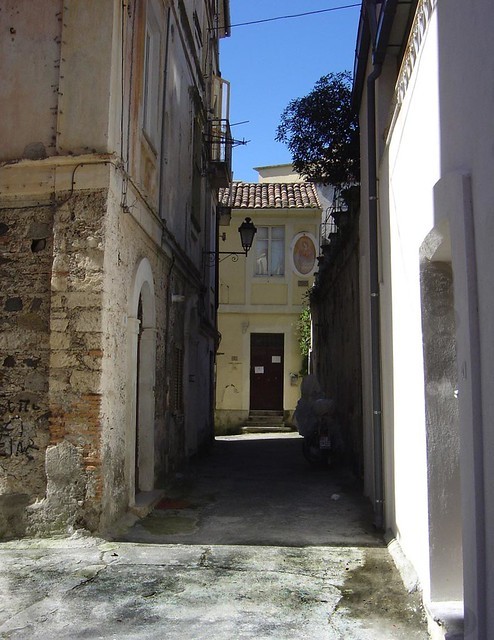

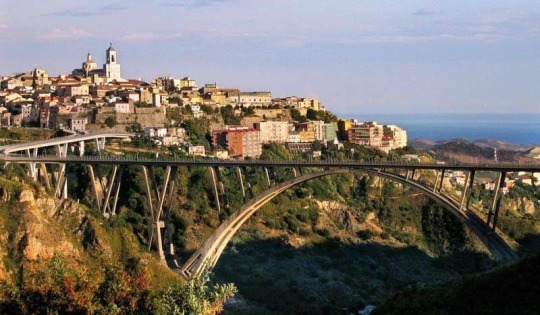
Catanzaro, Calabria, Italy
This ancient town which rises on a rock is the capital of the Calabria region. It was founded in 9th century by the Byzantines and was built over three hills in order to protect the town from the Saracen attacks arriving from the lonian sea.
At the beginning of the tenth century (c. 903), the city of Catanzaro was occupied by the Muslim Saracens, who founded an emirate and took the Arab name of قطنصار - Qatanşār.
An Arab presence is evidenced by findings at an eighth-century necropolis which had items with Arabic inscriptions. Around the year 1050, Catanzaro rebelled against Saracen dominance and returned to a brief period of Byzantine control.
Under the Byzantine dominion, between the end of the 9th and the beginning of the 10th century, Calabria was one was one the first places in Italy to introduce the breeding of the silkworm in the 11th century.
According to French historian André Guillou, mulberry trees for the production of raw silk were introduced to Calabria by the Byzantines at the end of the 9th century. Mulberry leaves are the only leaves that silkworms eat.
Around 1050, the theme of Calabria had cultivated 24,000, mulberry trees for their foliage, with growth still ongoing.
The peasants of the countryside around the city produced the raw silk, which was then woven in the silk workshops of Catanzaro. A large part of the population was involved in this business, and the silk of Catanzaro supplied almost all of Europe.
The silk was sold in a large market fair in the port of Reggio Calabria, to Spanish, Venetians, Genovese and Dutch merchants.
Today, three young friends have come together to bring local traditions back to the fore. In 2014 they decided to build their future in San Floro, a tiny village of 600 inhabitants near the city of Catanzaro and restore the traditional mulberry tree planting and cultivation needed for the rearing of silkworms. Historically, San Floro was famous for a very significant production of raw silk in the 17th century, though this heritage had been completely lost in modern times.
The only surviving elements of this rich legacy were the 3,000 abandoned mulberry trees and the memory of the elderly villagers. Miriam and her friends brought back the production of silk, rewinding the threads of history and travelling across the world to exchange best practices with silk institutes in Thailand, India, Switzerland, and France.
As part of its development, they trained people interested in their new, sustainable production model and also brought thousands of tourists from all over the world to visit their farm (Nido di Seta) to experience how silk is produced first-hand.
Catanzaro is a windy city due to its altitude and position between two seas. In fact, there is only 30 km separating the Ionian Sea from the Tyrrhenian Sea and Catanzaro is wide open to the constant strong breezes from the Ionian Sea and the Sila mountains.
Follow us on Instagram, @calabria_mediterranea
#catanzaro#calabria#italy#italia#south italy#southern italy#italian#mediterranean#silk#the silkworm#silk road#europe#architecture#textile#loom#mulberry tree#history#muslim#saracens#italian landscape#landscape#mediterranean sea#arab#byzantine#byzantine empire#weaving#nido di seta
21 notes
·
View notes
Text

A polychrome 'cartapesta' or papier-mâché bust of Christ in agony
with glass eyes, southern Italy, Lecce, 17th C.
Rob Michiels
27 notes
·
View notes
Text
currently reading immodest acts: the life of a lesbian nun in renaissance italy by judith c. brown and she just dropped the tidbit that at one point in the 16th/17th centuries if a woman had an “enlarged clitoris” it was an “assumption of guilt” that she was copulating with other women and therefore she should be hanged and then burned at the stake like…sorry your clit is too fat and juicy for what we don’t understand are completely normal reasons so you have to die
7 notes
·
View notes
Text
Classical Music in La Corda (Part 2)
Related Links:
An Introduction to La Corda
Classical Music in La Corda (Part 1)
(Article also available on Medium)
===
La Corda d’Oro (Kiniro no Corda, 金色のコルダ), published by KOEI in 2003

The below list of pieces appeared in the game La Corda d’Oro that was first released on September 19, 2003.
===
Air on the G String (G線上のアリア)
Composer: Johann Sebastian Bach (バッハ)
Category: elegant (清麗)
Keywords: passion, compliment, determination, reputation, aura, people, confidence, flower, life
This piece originates from Bach’s Orchestral Suite №3 that is called “Air”. In the arrangement by August Wilhelmj (in 1871), the violin melody is transposed such that the entire piece can be played on the violin’s lowest string (i.e. the G string). While the original key of Bach’s version is in D major, Wilhelmj’s version is in C major.
Romanze (ロマンスト長調)
Composer: Max Reger (レーガー)
Category: vivid (彩華)
Keywords: resonance, creation, bride, student, education, passion, hometown, youth, home
Romance (Romanze in German) generally refers to any vocal or instrumental piece that has a tender, lyrical quality. This piece, originally for violin and piano (original version), was first published in the magazine Neue Musikzeitung in 1901. It now has multiple different versions, including for flute, clarinet and cello.
Valse Sentimentale (感傷的なワルツ)
Composer: Pyotr Ilyich Tchaikovsky (チャイコフスキー)
Category: gloomy (愁情)
Keywords: despair, dream, admiration, dedication, goddess, love, encounter, suffocation, marriage
Valse Sentimentale is one of the “Six Pieces (Six morceaux) for solo piano”, Op. 51 that Tchaikovsky wrote for the bourgeois salons in 1882. Each of the piece is dedicated to a different person, and the final movement Valse Sentimentale is dedicated to Emma Genton — an important woman in Tchaikovsky’s life. The melancholic melody gives a sense of romance while vividly depicts the image of a beautiful woman. My personal favourite is this version arranged for violin.
Sicilienne (シチリアーノ)
Composer: Anonymous
Category: elegant (清麗)
Keywords: family, children, goal, passion, promise, prospect, career
According to the official fanbook or the game, Sicilienne is composed by the blind Austrian Maria Theresia von Paradis (パラディス). Say even in this online video, the piece is attributed to Paradis. However, latest research revealed that it is very likely a musical hoax by violinist Samuel Dushkin, who published the piece in 1924.
Sicilienne (also known as siciliano or siciliana), is a form of dance music for Sicilian folk dance in Italy, which was popular during the 17th and 18th centuries. The genre is often characterised by dotted rhythms and gives a pastoral feel.
Humoresques (ユーモレスク)
Composer: Antonín Dvořák (ドヴォルザーク)
Category: vivid (彩華)
Keywords: childhood, celebration, resonation, desire, heart
This piece was written when Dvořák returned to his homeland Czechoslovakia (now The Czech Republic) during the summer of 1984. He had been working as the director of the Conservatory in New York in the United States between 1892 and 1895. The piece was originally composed for the piano, comprised of both Czech and American style melodies.
Later, Dvořák’s Humoresque №7 became the tune that can be heard on passenger train toilets in the United States — the singing begins with “Passengers will please refrain from flushing toilets while the train is standing…” (full song here).
Après un rêve (夢のあとに)
Composer: Gabriel Fauré (フォーレ)
Category: gloomy (愁情)
Keywords: sentiment, unrequited love, reputation, farewell, self, dream, quietude, reputation, longing
Après un rêve (After a dream in English) is one of the pieces from Trois mélodies that Fauré wrote for solo voice and piano between 1870 and 1877. The lyrics originates from an Italian poem that recounts a dream where one’s beloved can be seen. The following shows the translation in English by Richard Stokes:
In sleep made sweet by a vision of you
I dreamed of happiness, fervent illusion,
Your eyes were softer, your voice pure and ringing,
You shone like a sky that was lit by the dawn;
You called me and I departed the earth
To flee with you toward the light,
The heavens parted their clouds for us,
We glimpsed unknown splendours, celestial fires.
Alas, alas, sad awakening from dreams!
I summon you, O night, give me back your delusions;
Return, return in radiance,
Return, O mysterious night!
In the game you could play this piece with a violin duet, and I really like the arrangement. Unfortunately I cannot find anything similar online, but this is another arrangement for 2 violins and piano.
===
Thank you for reading!
Reference: 金色のコルダ コンプリートガイド
2 notes
·
View notes
Text
From the main gallery in Volterra

Felix de Volturi, as painted by Orazio Gentileschi, C.  early 17th century

In 1615, the painter Orazio Gentileschi and his prodigy of a daughter, Artemisia, visited the Palazzo dei Priori in Volterra to paint a young nobleman of a rather private family, the Volturi.
Artemisia Gentileschi, who would be responsible for other works also featured in this gallery, aided her father in the construction of the piece.
She remarked however, that their muse must have been the most patient man in all of Italy, given that he sat incredibly still throughout its composition. He responded only with a shy smile.
Eventually, the two shared a rather long and indulgent conversation about the arts. We will not bore you with the details. Though, According to Felix, she told him that she had began working on the piece that would become her most famous, Judith Slaying Holofernes.
Orazio and Artemisia did find the young nobleman’s request for dull color rather odd but they obliged. They figured it had to do with his peculiar eye color.



“Felix had a crush on Artemisia!” Demetri all but shouted, clutching his stomach in laughter.
Felix rolled his eyes at his friend, nonetheless, a wistful look of reminiscence overtook his face, punctuated with a soft smile.
Demetri continued, “The reason he isn’t looking at the viewer in the painting is so that Orazio wouldn’t catch him making goo goo eyes at his daughter,” the tracker hyperventilated the words through his laughter, receiving a light but firm elbow jab to the ribs from Felix.
“The only reason I asked Orazio to paint it with an extended invitation to Artemisia was because I wanted to be a gentleman, so I didn’t invite her alone. Both of them were incredibly talented!Truly, I just wanted to talk to her!” Felix pleaded.
“Awww let Felix be a hopeless romantic, Demetri,” Heidi scolded.

#click on the picture for better quality#twilight#the volturi#demetri volturi#felix volturi#heidi volturi#from the gallery#art history#historical twilight#felix is a hopeless (roman)tic
35 notes
·
View notes
Text

Portrait of a lady by Maddalena Corvina, 1635-45
#Maddalena Corvina#17th century#mdp17th c.#1630s#1640s#mid 17th century#italy#17th c. Italy#Italian style
72 notes
·
View notes
Video
Something a bit different 😎 Paris Airshow 1983 by Heathrow Junkie
Via Flickr:
Highlight of the Paris Airshow 1983 😎 :) A close up of the Space Shuttle prototype OV-101 'Enterprise' on the back of NASA Boeing 747 N905NA, parked on show at the Paris Airshow at Le Bourget. N905NA c/n 20107 - Boeing 747-123 - delivered new to American Airlines in 1970 as N9668, the aircraft was converted in 1974 as a Space Shuttle carrier. The aircraft made it's only visit to the Paris Air Show in 1983, carrying the Space Shuttle 'Enterprise'. N905NA made its last flight with Space Shuttle 'Discovery' on 17th April 2012 from Kennedy Space Center - Washington Dulles, and was then stored at Ellington Field. Space Shuttle 'Enterprise' (NASA Orbiter Vehicle Designation: OV-101) - was the first Space Shuttle. It was built for NASA as part of the Space Shuttle program to perform test flights in the atmosphere, aided by modified Boeing 747 N905NA. It was constructed without engines or a functional heat shield, and was therefore not capable of spaceflight. During 1983 and 1984 'Enterprise' undertook an international tour visiting France, Germany, Italy, Canada and the UK. More on Space Shuttle 'Enterprise' here: en.wikipedia.org/wiki/Space_Shuttle_Enterprise Taken with a Soviet made Zenith TTL camera and standard lens. From an original slide, scanned with minimal digital restoration. You can see a random selection of my aviation memories here: www.flickriver.com/photos/heathrowjunkie/random/
13 notes
·
View notes
Text
Explaining one of VTMB paintings (pt 8)
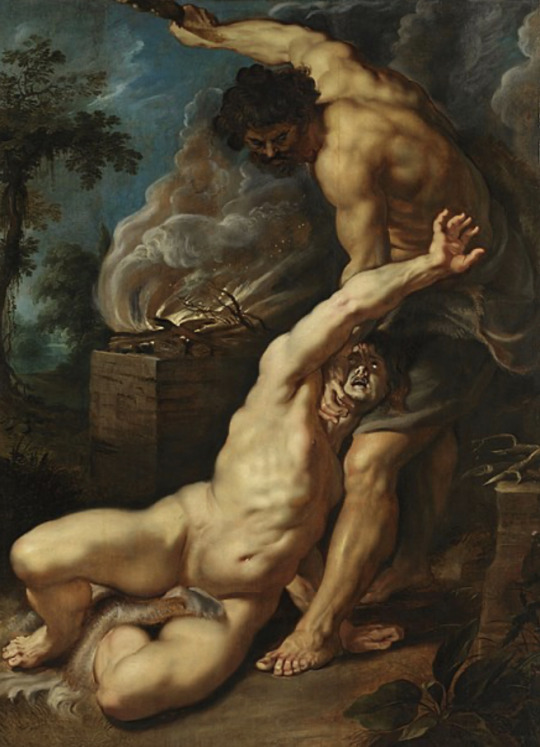
Cain Slaying his Brother Abel (Genesis 4:2-12) oil on oak wood (between 1608 and 1609) by Sir Peter Paul Rubens.
Sir Peter Paul Rubens (28 June 1577 – 30 May 1640) was a Flemish artist and diplomat from the Duchy of Brabant in the Southern Netherlands (modern-day Belgium). He is considered the most influential artist of the Flemish Baroque tradition. Rubens's highly charged compositions reference erudite aspects of classical and Christian history. His unique and immensely popular Baroque style emphasized movement, color, and sensuality, which followed the immediate, dramatic artistic style promoted in the Counter-Reformation. Rubens was a painter producing altarpieces, portraits, landscapes, and history paintings of mythological and allegorical subjects. He was also a prolific designer of cartoons for the Flemish tapestry workshops and of frontispieces for the publishers in Antwerp.[1]
The story of Baroque art in Flanders during the 17th century reflects the gradual decline of the country itself. Occupying the southern part of the Low Countries or Netherlands, it was ruled - along with the northern part of the Low Countries, known as Holland - by the unpopular Spanish Hapsburgs, who had taken over from the French Dukes of Burgundy. Its once powerful commercial and cultural centers, such as Bruges, Ghent and Antwerp, were weakened by religious and political disputes between the Catholic Hapsburg authorities and Protestant Dutch merchants. Thus while Dutch Baroque art flourished as never before, art in Flanders depended on a small handful of Flemish painters, mostly active in Antwerp.During the 15th century - the early days of the Italian Renaissance - Flemish painters had exported the technique of oil painting to artists in Florence, Rome and Venice. Now, at the beginning of the 17th century, with the spread of Italian Caravaggism, Flemish painters combined their own tradition with the tenebrist tradition arriving from Italy. This development was exemplified by the Antwerp artist Rubens (1577-1640). Since the High Renaissance, Flemish painting had been in transition between Northern and Italian influences; it was Peter Paul Rubens (1577-1640) who made the first real attempt to digest, absorb and fuse the two schools, creating a new style, well-suited to the more devout religious paintings called for by the Council of Trent's guidelines on Catholic Counter-Reformation Art (c.1560-1700), and which had a powerful impact on all painting north of the Alps.[2]
Below is an explanation of the Cain and Able story from real life and in the context of VTM. This is the same for all the Explained Cain slaying Able paintings in VTMB posts I’ve done so feel free to skip if you’ve already read this as it’s long.
___________________________________________________________
The tale of Cain murdering his brother Able are nearly identical in Jewish, Christian and Islamic texts with the oldest known version coming from the Dead Sea Scroll from the first century BCE. Cain was the the first born son of Adam and Eve and became a Farmer while Able was the second born son and became a shepherd. Both brothers made sacrifices to God, but God favored Abel's sacrifice instead of Cain's. In Islam the reason for their offerings is to decide which brother would marry Adam and Even’s first daughter who was also Cain’s twin sister. Able also had a twin sister and Adam wanted the brothers to marry the others twin. In multiple religions each brother has a twin sister but there is no consistently with the names as Cain’s twin sister being named Aclima, Kalmana, Lusia, Cainan, Luluwa, or Awan, and Able’s twin sister is named Jumella, Balbira or to make it more confusing Aclima (though even when she is called this Able’s twin sister is never the one the brothers are competing to marry) depending on the source. In the Islamic text Able’s offers his fattest sheep while Cain offered only a bunch of grass and some worthless seeds. In Jewish and Christian texts the reason for the sacrifices and the exact nature of their offerings are merely described as the first born of Ables heard and products from Cain’s fields.[3] The most description we get is in Genesis when God sees that Cain is upset that his offering was not chosen God tells Cain “: Why are you angry? Why are you dejected? If you act rightly, you will be accepted; but if not, sin lies in wait at the door: its urge is for you, yet you can rule over it.”(Genesis 4:6-7) Cain then told Able to meet him in his fields where he then murdered his brother out of jealousy by hitting Abel in the head with a stone. When God asks Cain where his brother Cain, “I do not know! he answered. Am I my brother’s keeper?”(Genesis 4:9) to which God replies “What have you done! The voice of your brother’s blood is calling to me from the ground. From now on you’ll get nothing but curses from this ground; you’ll be driven from this ground that has opened its arms to receive the blood of your murdered brother. You’ll farm this ground, but it will no longer give you its best. You’ll be a homeless wanderer on Earth.” (Genesis 4:10-12) When Cain objects saying the punishment is to great and that whoever finds him wandering shall kill him which then God says “No. Anyone who kills Cain will pay for it seven times over.” God put a mark on Cain to protect him so that no one who met him would kill him.” (Genesis 4:15). Cain then leaves east of Eden to wander in No-Mans-Land with his wife (who is not named in Genesis but is assumed to be his Twin sister in all tellings regardless of what name is given to her). Their first born Child was named Enoch, and Cain named the first city he built after his son. After Abel’s Death Adam and Eve had a Third son named Seth and when eve gave birth to him Eve said “God has given me another child in place of Abel whom Cain killed.”Genisis 4:25-26. In some texts Seths wife and sister is named Azura. Their son is named Enosh it is through Seth’s line that humanity stems from, though both Cain and Seth had multiple decedents and confusingly used the same names (see family tree below). None of Cain’s decedents suffered the curse of their father Cain but where still seen as sinful and apart from God and where killed in the great flood. How Cain died is not as an agreed upon topic. He was ether crushed to death by the stone house he built, an irony as he used a stone to slay his brother or in some versions part of the Mark of Cain had him grow horns and his descendent Lamech (not to be confused with Lamech who decedent from Seth and was the father of Noah) who was a blacksmith and had two wives(this is viewed as sinful) killed him mistaking him for a wild animal and killed his own son Tubal-cain in the process.

While in the lore of Vampire the Masquerade the tale of Cain killing his brother able as told in the Book of Nod stick to the original tale regarding the murder of Able but starts to differ in God’s punishment. "Father" cursed him with a mark, and cast him out to wander in darkness in the Land of Nod alone. There is no mention of a wife or if he was still cursed to be unable to farm however it is clear that Cain was not yet cursed to be a vampire by God. The Land of Nod was a place of utter darkness, with no source of light, where Caine was afraid and alone. There he found Lilith where they began a relationship and Cain realized that she possessed magical power and begged her to share them with him. While hesitant Lilith prepares an Awakening ceremony by cutting herself with a knife, bleeding into a bowl, and giving it to him so that he may drink. After Caine partakes of Lilith's blood, he is visited by three angels who are agents of God. Each angel offers Caine a chance to repent for the murder of Abel, but Caine rebuffed them out of pride. Michael, when denied, cursed Caine and his childer to fear his living flame. Raphael cursed Caine and his childer to fear the dawn, as the sun's rays would burn like fire. Uriel then cursed Caine and his childer to cling to Darkness, drink only blood, eat only ashes, and be frozen at the point of death, cursed so all they touch would crumble into nothing. A fourth angel, Gabriel, then appeared to offer the way of Golconda, the only way to "light", by the mercy of God. After the experience, Caine becomes officially "Awakened", possessing the following Disciplines: Celerity, Potence, Fortitude, Obfuscate, Dominate, Presence, Protean, Animalism, and Auspex. Caine then became aware of the Path of Blood, the Final Path from which all paths stem. And with all these powers, but now being cursed to be a vampire he breaks his bond with Lilith and leaves her.[3] While Cain never biologically fathers any children it is clear that their names of those he embraced and their decedents are inspired by the biblical names in his line though with massive changes. For instance the first city is founded by Cain in the land of Nod and and called Ubar and is explicitly stated to be settled by “Children of Seth” with the human king being Enoch at the time Cain settles there. Enoch still becomes his son as he is embraced by Cain. Another example of the reuse of a biblical name of cain’s line is Zillah (which in Hebrew means shade or protection). In the original story she is one of Lamech(decedent of Cain) two wives( the other named Adah). After both wives discover that Lamech unwittingly kills Tubal-Cain(one of Lamech and Zillah’s sons) they both refuse to have sex with him because of the deaths he caused, on the pretext that they do not desire to give birth to cursed offspring. The three go together to the tribunal of Adam; Adam rules that they must obey their husband since he killed unwittingly. This midrashic tradition portrays Adah and Zillah as respected women, whose position is considered in all seriousness by the court. [4] In VTM Zillah was a human woman who lived in Udar so beautiful, Caine could not resist the Embrace. According to Nosferatu Zillah is the one of Cain’s second generation who sired their Antediluvian. Interestingly, even after the Embrace, Zillah did not desire him. It frustrated Caine to the point that he was ripping his hair out of his head. He did anything and everything to make her desire him. Yet, she would not have him. Finally, Caine sought the Crone's magic, who ultimately tricked him into a blood bond, she forced the First Vampire to Embrace her. The Crone sent her new thrall away, telling him that his blood would have the power to bond others as Caine himself was bonded to the Crone. The discovery of the blood bond was what finally made Zillah agree to marry her sire Caine. [3]
[1] “Peter Paul Rubens.” Wikipedia, Wikimedia Foundation, 16 Mar. 2023, https://en.wikipedia.org/wiki/Peter_Paul_Rubens.
[2]“Flemish Baroque Art (1600-80).” Flemish Baroque Art (1600-80), ENCYCLOPEDIA OF ART HISTORY, http://www.visual-arts-cork.com/history-of-art/flemish-baroque.htm#flemishbaroque.
[3] “Caine.” White Wolf Wiki, https://whitewolf.fandom.com/wiki/Caine.
[4] Kadari, Tamar. “Zillah: Midrash and Aggadah .” Jewish Women's Archive, https://jwa.org/encyclopedia/article/zillah-midrash-and-aggadah#:~:text=Zillah%20was%20a%20wife%20of,he%20unwittingly%20kills%20Tubal%2DCain.
#VTMB#vampire the masquerade#cain and abel#sir peter paul rubens#flemish baroque art#Explaining one of VTMB paintings#VTM#Four painting for the price of one#book of nod
5 notes
·
View notes
Text
Holidays 11.4
Holidays
Air-Conditioned Automobile Day
Bad Mood Day
Chair Day
Chicken Lady Day
Citizenship Day (Northern Mariana Islands)
Community Service Day (Dominica)
Day of Love (Egypt)
Flag Day (Panama)
Giorno dell’Unita Nazionale e Festa delle Forze Armate and Victory Day (Italy)
Honeymoon Day
International Cake Day
King Tut Day
Medical Science Liaison Awareness and Appreciation Day
Mischief Night (UK, Australia, NZ)
National Advent Calendar Day
National Easy-Bake Oven Day
National Professional Paint Contractors Day
National Skeptics Day
National Tonga Day (Tonga)
National Unity and Armed Forces Day (Italy)
Thanksgiving Day (Liberia)
Unity Day (Russia)
Use Your Common Sense Day
Victory Day (Italy)
Waiting for the Barbarians Day
Will Rogers Day (Oklahoma)
Yitzhak Rabin Memorial Day
Food & Drink Celebrations
National Candy Day
1st Friday in November
Fountain Pen Day [1st Friday]
J-Day (@ 8:59 PM, Tuborg releases Julebryg; Denmark) [1st Friday]
Love Your Lawyer Day [1st Friday]
National Jersey Friday [1st Friday]
National Medical Science Liaison Awareness and Appreciation Day [1st Friday]
World Community Day [1st Friday]
Feast Days
Americus (Christian; Saint) [America]
Boccaccio Day (Church of the SubGenius; Saint)
Brinstan (Christian; Saint)
Charles Borromeo (Roman Catholic Church)
Emeric of Hungary (Christian; Saint)
Feast of Qudrat (Power; Baha'i)
Federico Pelini (Muppetism)
Felix of Valois (Christian; Saint)
Hume (Positivist; Saint)
Joannicius the Great (Christian; Saint)
Listen to Sea Shanties and Dance Like a Pirate Day (Pastafarian)
Ludi Plebii begins (a.k.a. Plebian Games until 17th; Ancient Rome)
Not the Zombie Apocalypse Day (Pastafarian)
Our Lady of Kazan (Russian Orthodox Church)
Pierius (Christian; Saint)
Sigd (ends at Sundown) [Hebrew, Cheshvan 29]
Teresa Manganiello (Christian; Blessed)
Vitalis and Agricola (Christian; Saint)
Lucky & Unlucky Days
Taian (大安 Japan) [Lucky all day.]
Premieres
Chicken Little (Animated Film; 2005)
The Crown (TV Series; 2016)
Doctor Strange (Film; 2016)
The Fifth Elephant, by Terry Pratchet (Novel; 1999) [Discworld #24]
The Flash (Film; 2022)
G.I. Blues (Film; 1960) [Elvis Presley #5]
Great Performances (TV Anthology Series; 1972)
Hacksaw Ridge (Film; 2016)
Harry Potter and the Philosopher's Stone (Film; 2001) [#1]
The Interpretation of Dreams, by Sigmund Freud (Book; 1899)
The Jungle, by Upton Sinclair (Novel; 1905)
The Last Waltz (Concert Film; 1977)
The Man Who Sold the World, by David Bowie (Album; 1970)
Rocket to Russia, by the Ramones (Album; 1977)
Symphony No. 1 in C, by Johannes Brahms (Symphony; 1876)
A Very Harold & Kumar 3D Christmas (Film; 2011)
Walking on the Moon, by Police (Song; 1979)
Weird: The Al Yankoic Story (Film; 2022)
Today’s Name Days
Karl (Austria)
Drago, Dragutin, Karlo (Croatia)
Karel (Czech Republic)
Otto (Denmark)
Erla, Erle, Herta (Estonia)
Hertta (Finland)
Aymeric, Charles, Jessé (France)
Charles, Karl, Karla, Modesta (Germany)
Károly (Hungary)
Carlo, Guido, Rosalia (Italy)
Atis, Oto, Otomārs (Latvia)
Eibartas, Karolis, Vaidmina (Lithuania)
Ottar, Otto (Norway)
Emeryk, Karol Boromeusz, Mściwój, Olgierd, Witalis (Poland)
Karol (Slovakia)
Amancio, Carlos (Spain)
Nore, Sverker (Sweden)
Amory, Cara, Carl, Carla, Carley, Carlie, Carlo, Carlos, Carly, Carol, Carolina, Caroline, Carolyn, Carrie, Carroll Charles, Charlie, Chaz Chuck, Emery, Karl, Karla, Karlee, Karli, Karly (USA)
Today is Also…
Day of Year: Day 308 of 2022; 57 days remaining in the year
ISO: Day 5 of week 44 of 2022
Celtic Tree Calendar: Hagal (Constraint) [Day 7 of 28]
Chinese: Month 10 (Lùyuè), Day 11 (Xin-You)
Chinese Year of the: Tiger (until January 22, 2023)
Hebrew: 10 Cheshvan 5783
Islamic: 9 Rabi II 1444
J Cal: 8 Mir; Sunday [8 of 30]
Julian: 22 October 2022
Moon: 86%: Waxing Gibbous
Positivist: 28 Descartes (11th Month) [Hume]
Runic Half Month: Ngetal (Reed) [Day 10 of 15]
Season: Autumn (Day 43 of 90)
Zodiac: Scorpio (Day 13 of 31)
2 notes
·
View notes
Text
UEFA Euros 2022 Primer
Hooboy, the Women’s UEFA Euros are here and I am pumped to share my thoughts, feelings and observations on as much of it as I can consume, including writing up a preview for friends and fam who might want to follow along.
First warning: my perspective is from the bias of mostly following these professional leagues: WSL (England), UEFA Champions League (Europe) and NWSL (USA). That also means that the majority of my coverage/live-viewing recommendations will be USA/UK based, but I’ll try to include links to other general resources as much as possible.
Second warning: I love this shit and I am mostly doing it for me. That is to say, it might not be the most user-friendly and I’ll maybe ‘go long’ on aspects that aren’t essential to actually watching football. I’ll try to organise things so you can get the basics with optional deep dives, but no promises.
Ok, let’s do this.
Where to Watch
UK: The Beebs
US: ESPN Networks
The WEUROs website also has a page with comprehensive information about coverage globally.
How the Tournament Works
The Euros will take place over the month of July 2022 in England, with the opening match occurring on 6th of July and the final taking place on the 31st of July (here's a link to a calendar share of all of the games if you want to save them). Sixteen teams qualified for the tournament and they’re allocated into four groups, where they will play every other team in their group to determine who moves to the quarterfinals. From that point, it’s a traditional tournament format, with single elimination games reducing team numbers from 8 to 4 (semi-final) to 2 (final). Look, UEFA made some nice graphics to explain.
JK, it’s a bit of a mess (and also now out of date because Russia is no longer included and has been replaced by Portugal), but if you're not bothered by the England branding, here's a nice Euro 2022 wallchart produced by the Lionesses graphics team.

What To Expect
I'll do separate posts about each group, but here's a summary of thoughts on the whole thing, while attempting to avoid big predictions.
Anybody's Tournament
This really could be any team's to win (with the exception of a couple teams who would be incredibly fortunate to make it out of their groups, ahem, N. Ireland & Portugal, ahem). It's going to be competitive and some dominant teams on paper might not make it to the knock-out stages.
Final Four
Based on competitive games and expectations coming in, a semi-final group of England, Spain, Sweden and France would be a safe choice, and a delight to watch.
Based on vibes and potential alone, a final four of Norway, Denmark, Iceland and Italy would have great 'chaotic good energy'. This is also my line-up of dark horses to disrupt things this summer.
Who to Watch
Outside of team/group breakdowns, here are 5 players I'm excited to watch/hope have a great tournament, in no particular order:
Sveindís Jane Jónsdóttir (Iceland)
Pernille Harder (Denmark)
Marie-Antoinette Katoto (France)
Aitana Bonmatí (Spain)
Ella Toone (England)
Group Previews
Group A: The Home Draw
Group B: The Group of Death
Group C: The Holders et al.
Group D: The Disruptors
Round Check-Ins
Round 1.5 (Wednesday, 17th July)
Quarter Final Previews
QF1 (England v. Spain) & QF2 (Germany v. Austria)
QF3 (Sweden v. Belgium) & QF4 (France v. Netherlands)
3 notes
·
View notes
Photo

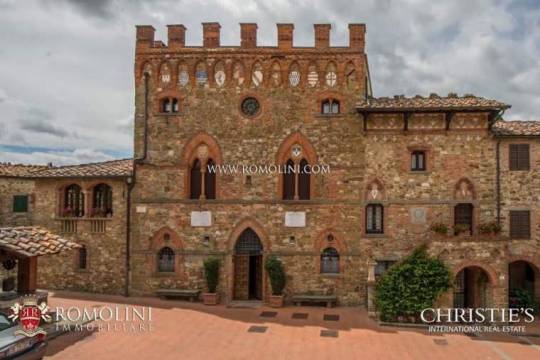
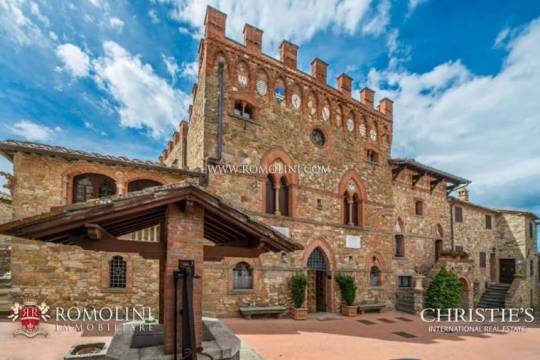
This is real 12th cen. castle in Tuscany, Italy. That it even exists and is beautifully preserved is amazing. It was restored for the first time in 1907 and if you want to know the price, you have to ask, b/c it’s probably outrageous.



The castle (800 sqm) (8,611 sqft) is located in the center of the medieval hamlet, and constitutes one of the four sides of the main square. On the inside (and a small annex) 9 luxury mini-apartments with just as many double (or twin) bedrooms with en suite bathrooms.

How crazy is this? Frescos & carved stone walls perfectly preserved.


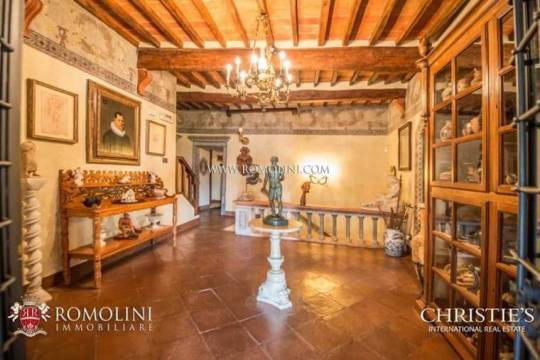
And, of course they had to electrify it, put in plumbing, etc. The property is then completed by three independent apartments located in the surrounding hamlet, a gym with dressing room, a garage and some storage rooms.
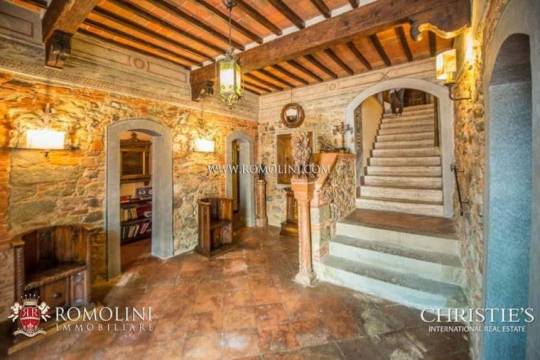
The interior remains magnificent with lots of the original structure.


Even though it’s split into apts., it still looks like a medieval castle.
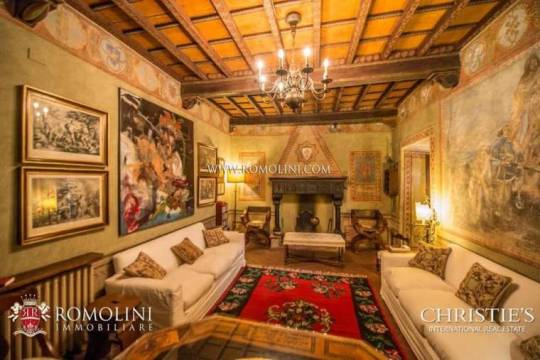

Original fireplaces and lots of those wonderful frescos.

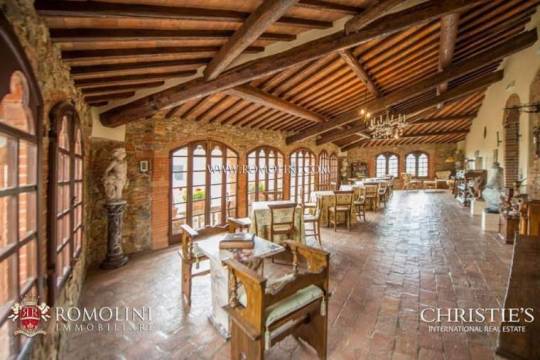
Look at this dining hall.

That carved lion.
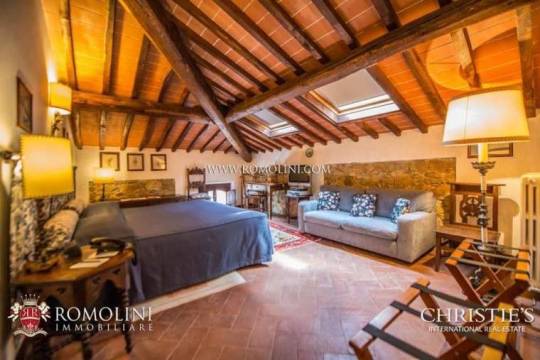
Then, it starts to get modern at this point in a guest area.


And, it goes full-on cheap tile shower, sauna and elevated toilet.

The first trace of a hamlet, though, dates back to the Langobardic era, just after the fall of the Ostrogothic Kingdom in 553 AD. The medieval castle itself was probably built in the 12th century and in 1385 it was gifted by the owners to the First Florentine Republic (1115-1434 AD) which used it as a defensive fortress in its long war against Siena.

Its position exposed the castle to numerous attacks and pillages. Uh-oh, it wasn’t in the best location- can you imagine being up here, watching attackers and pillagers storm the castle?

The gardens are stunning. But, the worst episode took place in 1528 and the castle suffered heavy damage. Between the 16th and 17th century the castle was rebuilt and the hamlet developed to the extent it is today.


In 1907 the castle was restored, but the architect who worked on the building modified the complex adding several anti-historical traits. The last restoration, which led to the conversion of the building into a luxury hosting activity, took place in 1997.


Here’s a little guest facility that’s very modern. All-in-all, it’s a good restoration.
https://www.captivatinghouses.com/2020/07/23/12th-century-italian-castle-for-sale-in-tuscany-italy/
#12th cent. medieval castle#ancient tuscan castle#long post#medieval castle restoration#architecture
208 notes
·
View notes